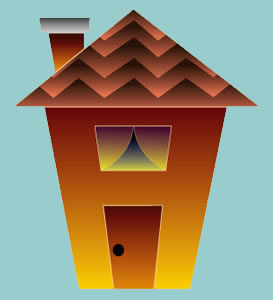
Unit 5 Activities
Pair
“House Designers”
Estimated time:
60 minutes
Materials:
Old magazines with pictures of furniture and other house-hold items/scenery,
large pieces of paper, markers or crayons
Objective(s):
The students will write labels for furniture and household items/scenery
in the target language.
The students will work collaboratively to create a “dream house”
on paper, using the target language.
The students will present their “dream houses,” orally.
The students will ask and answer questions about their “dream houses.”
Procedure:
The teacher/parent tells the students that they will be designing a house
today. They will then get the opportunity to “show” their
“dream houses” like a realtor! The students work in pairs
(or small groups) to design a dream house. They can draw or cut and paste
magazine pictures to create their houses. Using vocabulary from Unit 5,
they label items found in their house, and practice saying the names of
these items out loud. After the “dream houses” are complete,
each pair presents their project to the group using the target language.
It is fun for the students to engage in a “role-play” by pretending
to be realtors showing their “dream houses.” For example,
students in the group can ask questions like, “Is there a table?”
or “Where is the bedroom?” and the realtors can answer appropriately.
The teacher/parent should remind students of and provide the necessary
vocabulary and sentence structures found in Unit 5.
Assessment/Monitoring Progress:
Most students will enjoy designing and labeling their “dream houses,”
and this can be a nice, quiet activity in which they work collaboratively
with their peers. Presenting the houses might be challenging for some
students. Expect some students to take a leadership role, while others
do not speak as much. This is to be expected. If a majority of the students
are having trouble presenting the houses or asking and answering questions,
the teacher/parent can take over the presentation role, with the students
serving as “helpers.” For example, the teacher/parent can
describe the “dream houses” while the students who created
them point to the items/areas being described.
The students can put their creations in their “sleuthing books,” or the “dream houses” can be displayed in the classroom or other area.
Group
“Personal Passports” (Present to group)
Estimated time:
40 to 60 minutes
Materials:
Large pieces of paper, markers or crayons
Objective(s):
The students will write descriptions of themselves.
The students will create “personal passports” in the target
language.
The students will present/read their passports to the group.
Procedure:
The teacher/parent tells the students that they will be going on an imaginary
trip to catch a thief who has left the country. The students are asked
what they will need to go on a trip overseas. The teacher/parent asks
the students if they will need a passport, and what information would
need to be on the passport.
Fold the paper in half length-wise (to make a long rectangle), and open it up again. Fold the paper in half width-wise (to make a fat rectangle). Fold it one more time in the same direction, and then open it up half way (so you have a paper folded in half once, width-wise. Cut a slit in the middle of the paper by cutting perpendicular to the fold, going until you reach the next fold line. The books can then be flipped and folded into a book-shape that will stay folded. On each of the pages, students use the target language to write personal information, such as their name, birth date, physical description, age, etc. They should draw a corresponding picture for each page. When the “passports” are complete, the students should present/read their passports to the class. The class can then take an imaginary trip using their passports. (Perhaps they could pretend to board a plane, and the teacher/parent could “stamp” their passports, etc.). Another fun extension activity would be to mix up the passports, and make the students find the correct owner by asking their classmates questions in the target language.
Assessment/Monitoring Progress:
Each passport will be individual, which is to be expected and encouraged.
Understand that students will have varying degrees of ability in writing
and presenting in the target language. Encourage students to write about
themselves and to take pride in their work. Students should be able to
write some things about themselves in the target language. If they have
trouble with spelling or remember vocabulary, write it on the board or
another place that they can refer to.
The students can copy their work on a sheet of paper and include it in
their “sleuthing books.”